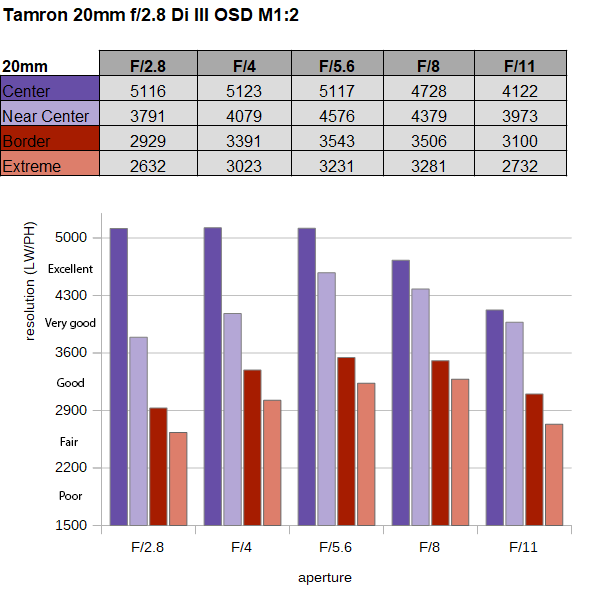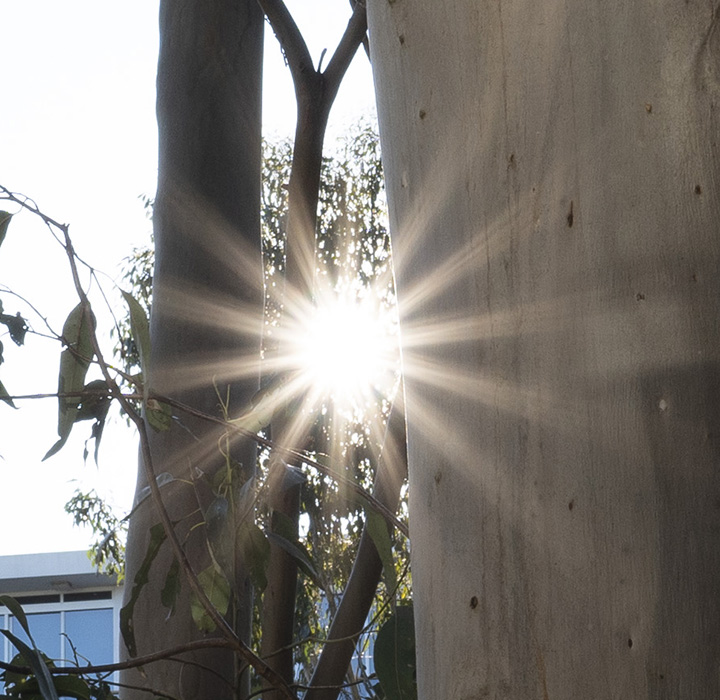|
Tamron 20mm f/2.8 Di III OSD M1:2 - Lab Test / Review - Analysis |
|
Lens Reviews -
Sony Alpha (Full Format)
|
|
Page 2 of 2

Distortion
The Tamron 20mm f/2.8 Di III OSD M1:2 produces an extreme amount of barrel distortion (~7.1%) in RAW files making the lens unsuitable for use without image auto-correction. It's among the worst-performing full format lenses in this respect that we have tested to date. With auto-correction, there's little to worry about here but it'll have impacts on the effective resolution characteristic as we'll see later on.
Vignetting
The vignetting characteristic is typical for such a lens. Without auto-correction, the light falloff is heavy at just short of 3EV (f-stops) at f/2.8. Stopping down isn't overly effective in solving the issue with almost 1.7EV of vignetting remaining at f/8.
Activated auto-correction reduces the issue substantially by 1.5EV (f-stops) at f/2.8. The remaining light falloff is still visible but not drastic anymore. The vignetting is acceptable from f/5.6 in this case.

MTF (resolution)
The MTFs have to be discussed in two chapters this time. Let's start with readings taken off RAW files first. The dead center is extremely sharp straight from f/2.8. There is a substantial drop in quality in the near-center zone already but the results are still very good here. The outer image region follows with good quality - which is commendable for such an ultra-wide lens. Stopping down is primarily boosting the resolution in the broader center zone reaching excellent results at f/5.6. The borders/corners don't benefit quite as much with a good to very good peak at f/5.6. Diffraction has, as usual, a higher impact from f/8 and beyond. f/11 remains perfectly usable albeit on a somewhat lower level.
The centering quality of the tested sample was good. Field curvature is moderate.
Please note that the MTF results are not directly comparable across the different systems!
Below is a simplified summary of the formal findings. The chart shows line widths per picture height (LW/PH) which can be taken as a measure for sharpness.
If you want to know more about the MTF50 figures you may check out the corresponding Imatest Explanations

The above is only part of the story though. Nobody is going to use this lens without distortion correction and this takes a toll on the resolution due to the required stretching especially in the outer image field. While the broader center is just marginally affected, the borders/corners are tanking in quality. Some softness is apparent at f/2.8 and the quality never exceeds good levels at optimal aperture settings. That's still not bad for a 20mm but nothing to write home about either.

Chromatic Aberrations (CAs)
CAs are very low with an average CA pixel width around 1px at the image borders. Lateral CAs can be eliminated via auto-correction without a loss in image quality so it's not really an important aspect anymore.

Bokeh
In order to achieve a shallow depth-of-field with a 20mm f/2.8 lens, you will have to choose very close focus distances. However, one of the features of the Tamron lens is its capability to focus down to just 11cm so there is quite some potential here.
Out-of-focus highlights are circular in the center zone at f/2.8. The inner zone of the discs is just slightly busy and there is some outlining. The circular shape is mostly maintained at f/4 but the edgy 7-blades aperture is getting very obvious from f/5.6 onward and the outlining is also emphasized.
 The following sample crop illustrates the focus transition towards the background - taken at f/2.8. The bokeh is a bit more busy compared to the Tamron 24mm f/2.8 Di III but still alright for a 20mm lens.
The following sample crop illustrates the focus transition towards the background - taken at f/2.8. The bokeh is a bit more busy compared to the Tamron 24mm f/2.8 Di III but still alright for a 20mm lens.

Sunstars
The Tamron lens produces fan-like sunstars as you can see below - taken at f/11.
 When looking at the highlight discs across the image frame, the circular shape is maintained in a fairly broad center zone. As so often the discs deteriorate towards the corners but the effect is actually comparatively mild. Stopping down doesn't really improve the already good rendering.
When looking at the highlight discs across the image frame, the circular shape is maintained in a fairly broad center zone. As so often the discs deteriorate towards the corners but the effect is actually comparatively mild. Stopping down doesn't really improve the already good rendering.
Competition
Within the price scope, there is probably two direct competitor - the Samyang AF 18mm f/2.8 (shown to the right below) and Tokina FíRIN 20mm f/2 FE (center). The Samyang lens is slightly more expensive but more attractive (better) overall. The build quality is similar but the Samyang lens is substantially smaller and more lightweight. You can, however, expect fewer sample variations with Tamron lenses. The Tokina 20mm f/2 FE comes at about twice the cost of the Tamron 20mm f/2.8 but it's also a full stop faster, has a superior build quality and is also better at medium apertures at least. There is, of course, also an offering by Sony - the Sony FE 20mm f/1.8 G (not shown). The Sony lens is the gold standard in this class but you have to pay extra for the privilege and the faster speed.
 Visual comparison courtesy of camerasize.com.
Visual comparison courtesy of camerasize.com.
Verdict
The Tamron 20mm f/2.8 Di III OSD M1:2 is a bit of a complicated being. Obviously, it's not meant to be used without image auto-correction. Especially the massive (unusable) barrel distortion requires countermeasures. With all corrections in place, the center performance of the lens is just outstanding but there's a sharp drop in resolution towards the outer image field at f/2.8. The quality of the outer image field improves when stopping down and is decent albeit unimpressive at medium aperture settings. Lateral CAs are low. There is some vignetting at f/2.8 even with auto-correction but it's an acceptable compromise and fairly well-controlled when stopped down. The quality of the bokeh is good for an ultra-wide lens.
If you have read our reviews of its cousins, you know already that we aren't all that thrilled by the build quality. The rather mediocre plastics and sluggish AF don't scream quality. However, in all fairness - this has to be seen relative to the low price tag. Keeping this in mind, it's almost surprising that the lens features some degree of sealing against moisture as well as an impressive close focus capability with an object magnification ratio of up to 1:2.
Overall, the Tamron 20mm f/2.8 Di III OSD M1:2 is a good lens for a great price but it's not an obvious choice.
Mechanical Quality:
★★★★★
What does this mean ?
|